Ingredients to run with
September 7, 2022
Reading Time: 7 minutes
Filed under Branding, Naming, Naming Architecture
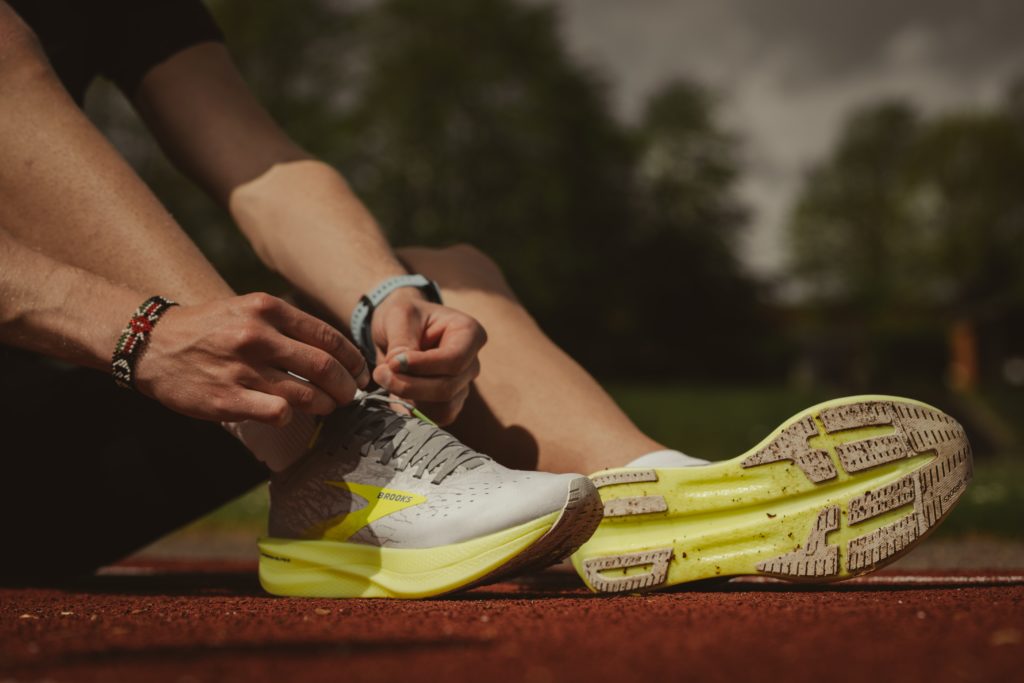
Taking a closer look at running shoe ingredient branding
There is a vast world of running shoe ingredient brands. What started with Nike Air and Asics Gel has exploded into a supernova of running technologies™️. While these running companies are busy churning out new innovations, what are they actually communicating to their customers? Do runners see value in these ingredient brands? Can they even remember them? What follows is an analysis of how running shoe companies use ingredient brands as well as simple steps they can take to improve their relationships with runners.
Approach:
First, I catalogued the ingredient brands for 12 of the biggest running shoe manufacturers sold in the United States. In alphabetical order, that’s Adidas, Altra, Asics, Brooks, Hoka One One, Mizuno, New Balance, Nike, On, Reebok, Salomon, Saucony. Swiss brand On Running had the fewest ingredient brands with four. Saucony had the most with 34. The mean average was 11. While there are hundreds of other companies that make running shoes, I was prioritizing a representative sample of what runners actually wear over being exhaustive. You can look at all 129 ingredient brands here.
I also sent out a three question survey to self-identified runners over Twitter and Instagram. Thank you to Holly (@fueledbylolz) for spreading the word. The three questions I asked:
1. What running shoes do you wear?
2. Without looking, can you name any ingredient brands for your running shoes?
3. Without looking, can you name any ingredient brands for any running shoes?
Results:
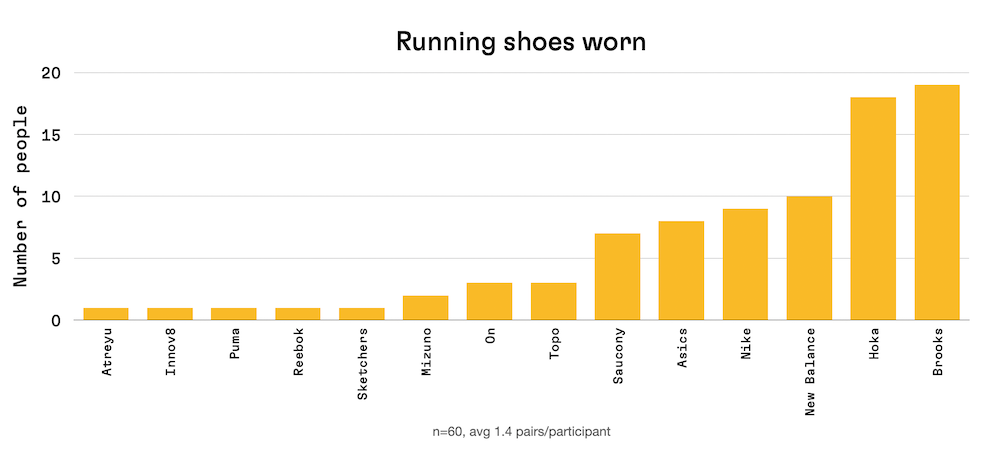
Brooks and Hoka were the most popular brands. Hoka uses a relatively small amount of ingredient branding (5 ingredients) while Brooks uses 10, which is right around average across the brands surveyed.
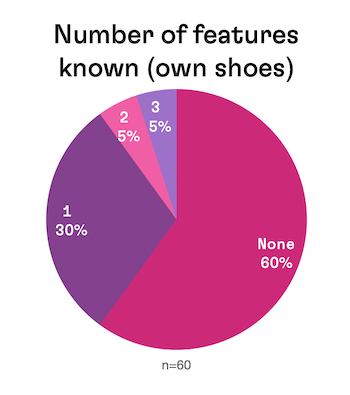
60% of respondents could name no ingredient brands for their running shoes. Another 30% could name one feature, which means 90% of respondents fell into these two categories. The most features anyone could name on their own shoes was three.
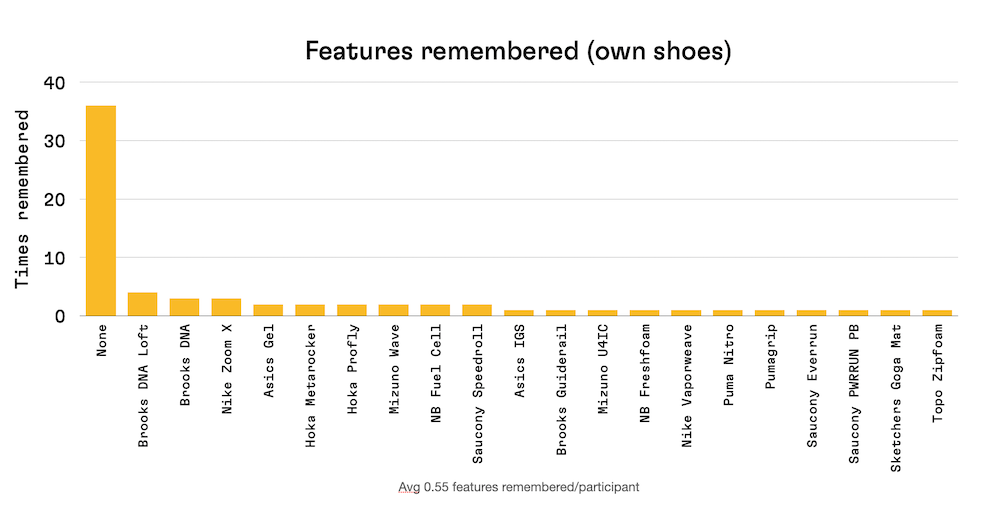
The most memorable ingredient brands on runner’s own shoes were:
- Brooks DNA Loft
- Brooks DNA
- Nike ZoomX
These were the only ingredient brands remembered by three or more participants. Brooks was the most worn running shoe in the respondent group (19). Seven out of 19 Brooks runners remembered an ingredient brand (37%) on their shoes.
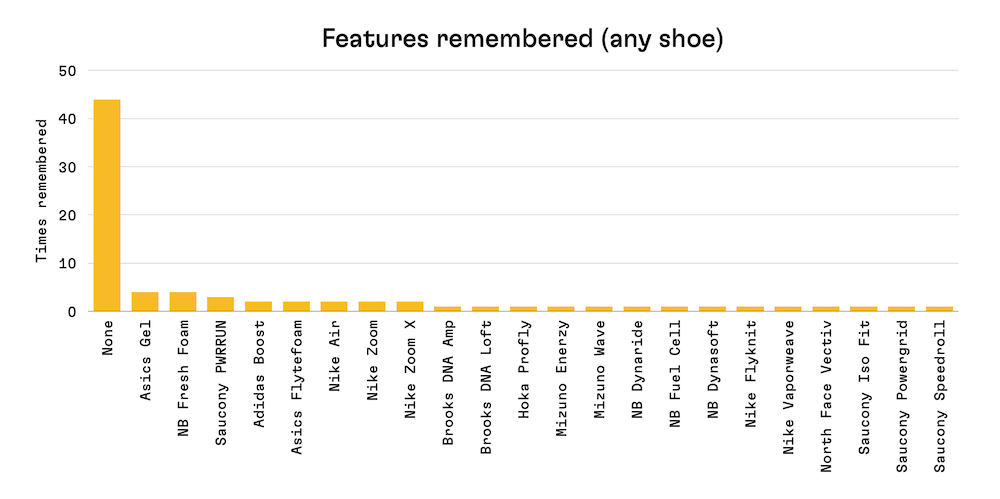
When asked about ingredient brands on any running shoes, 44 of 60 respondents (73%) couldn’t recall an ingredient brand. This could be because they are being asked about shoes they don’t currently wear although it stands to reason that more established ingredient brands like Nike Air and Asics Gel should be easier to recall.
The most memorable ingredient brands on running shoes not owned by participants were:
- Asics Gel
- New Balance Fresh Foam
- Saucony PWRRUN
These were the only ingredient brands remembered by three or more participants.
Special thanks to Allie for helping me pull everything together and analyze the data.
Analysis:
Why do companies use all of these ingredient brands if people can’t remember them? This is the biggest question I want to address here. There are a couple of potential answers:
- Manufacturers need something to sell and market. It’s hard to convince people they need new running shoes if there isn’t anything demonstrably new about them. Ingredient brands are easy ways for the manufacturers to point to something new and exciting. However, this creates a problem at the same time. A lot of runners grow really attached to a specific year/model of a shoe. When the manufacturers tinker, they run the risk of turning off established customers. There’s a balance to strike here: it’s nice to have new features every once in a while, but it’s likely more important not to alienate people who already love your shoes. If it ain’t broke…
- Manufacturers want to be seen as innovators. Just because you invent a new technology, doesn’t mean you need to give it a name. When you resist the temptation to name new features/ingredients, the brand equity you’re creating goes directly into the product or the parent brand. For example, when Brooks developed DNA Loft they could have put the technology into their shoes without giving it a name. If they did this, people would say things like “These Adrenalines have great cushioning” or “My Brooks have really lightweight cushioning.” If people can’t remember your ingredient brands, this transfer of brand equity is happening whether the manufacturers intend it or not.
- Manufacturers are engineering-driven organizations. Engineers love to put names on things because it makes them feel like their work is valuable and they can point to what they worked on. This is as true in running shoes as it is in software or automobile manufacturing. It stands to reason that when someone works hard on inventing something new, they want credit for it. Patents, trademarks, and visibility in general make these little inventions feel more important. The problem is, customers clearly don’t have an appetite for it.
Do ingredient brands help at the point of sale?
It’s certainly possible—to an extent. I find it hard to believe that Saucony’s 37 ingredient brands do anything but confuse people (they literally have a glossary of terms). But if you have a particular concern when buying running shoes, say pronation or forefoot cushioning, and a manufacturer has a specific ingredient brand that speaks to your concern—it can certainly help. In these instances it says that the manufacturer cares—that they considered your concerns and specifically developed a solution. Once you factor in how competitive the running market is, this argument starts to fall apart a bit. Almost every manufacturer has a branded cushioning system—some have several. So if you get into the differences between PWRRUN, Float Foam, and Fuel Cell, people will likely only be able to point to visual differences, if anything.
One other thing to consider here is online vs in store. Ingredient brands definitely existed before shoes were sold online but online sales gives these brands a customizable platform to share their technologies and innovations exactly how they want to. They can use videos, testimonials, CAD schematics. In store is a much more challenging environment to get these ideas across. While some stores have product displays, others are just walls of boxes. There’s no “standard” retail environment.
Visual differences are powerful.
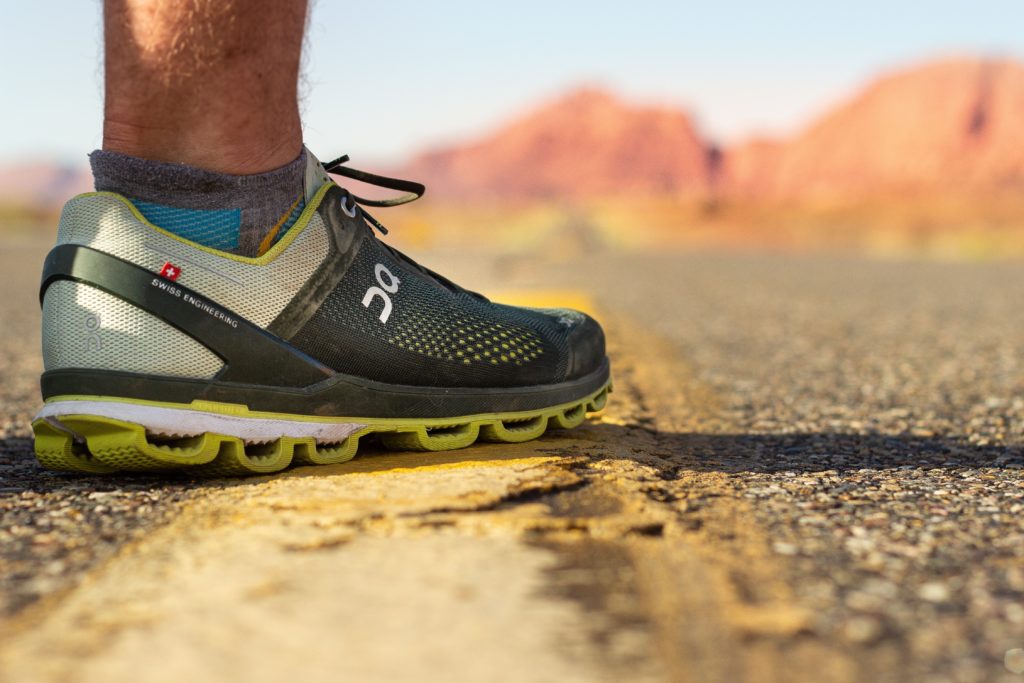
The biggest innovations in running shoes are plain for the eye to see. Sometimes these are branded ingredients like Asics Gel, other times they’re part of the overall brand like Hoka having a lot of cushioning or Altra having a wide toe box. Branded or not, these visual distinctions are the most powerful elements in running shoe branding. They work for established players (Nike Air) as well as newcomers (On CloudTec).
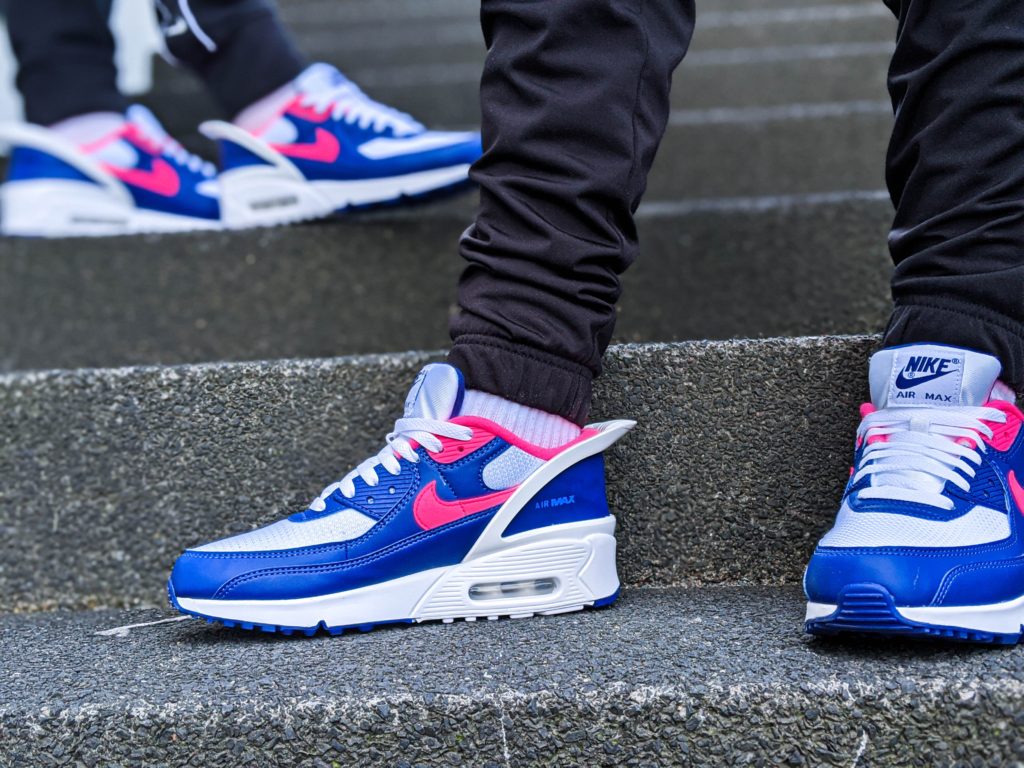
Nike Air: Having Air cushioning was an innovation but the real difference was the little window where you could see it. Hide that air cushion behind some foam and it wouldn’t be nearly as iconic.
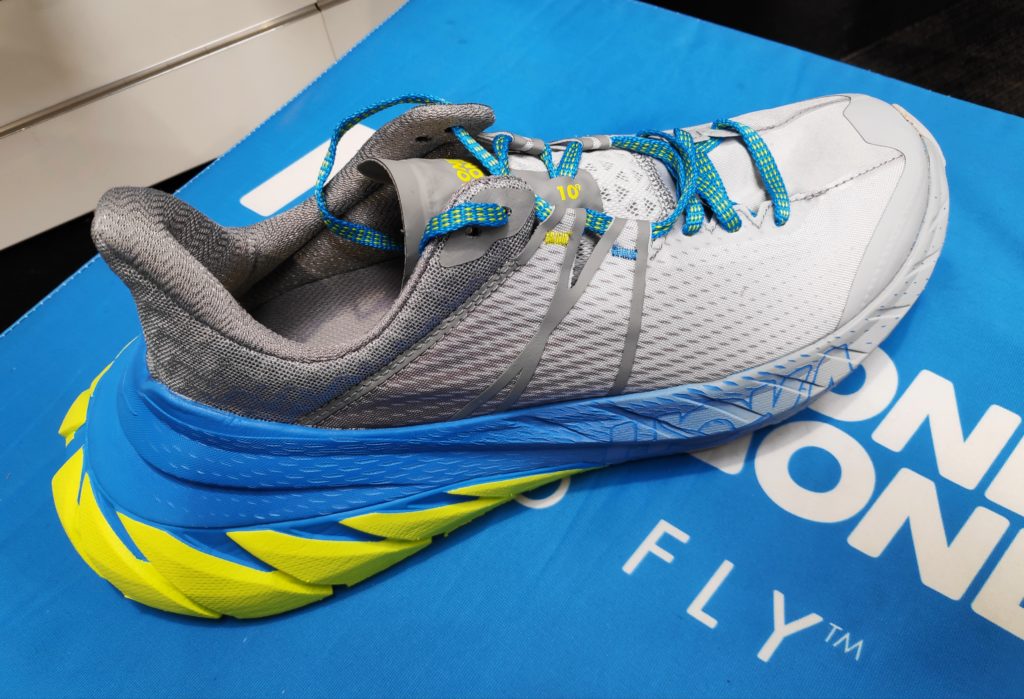
Hoka and On’s cushioning: When Hoka first hit the scene their cushioning looked comic—like a thought bubble in a sunday morning cartoon. While some people might have made fun of it, it was instantly recognizable. On’s cushioning system is easily recognizable because you can literally see through it. Not only that, you can see it flex. If these brands got the same results while keeping the visual profile in line with traditional running shoes they’d just be newcomers struggling for shelf space.
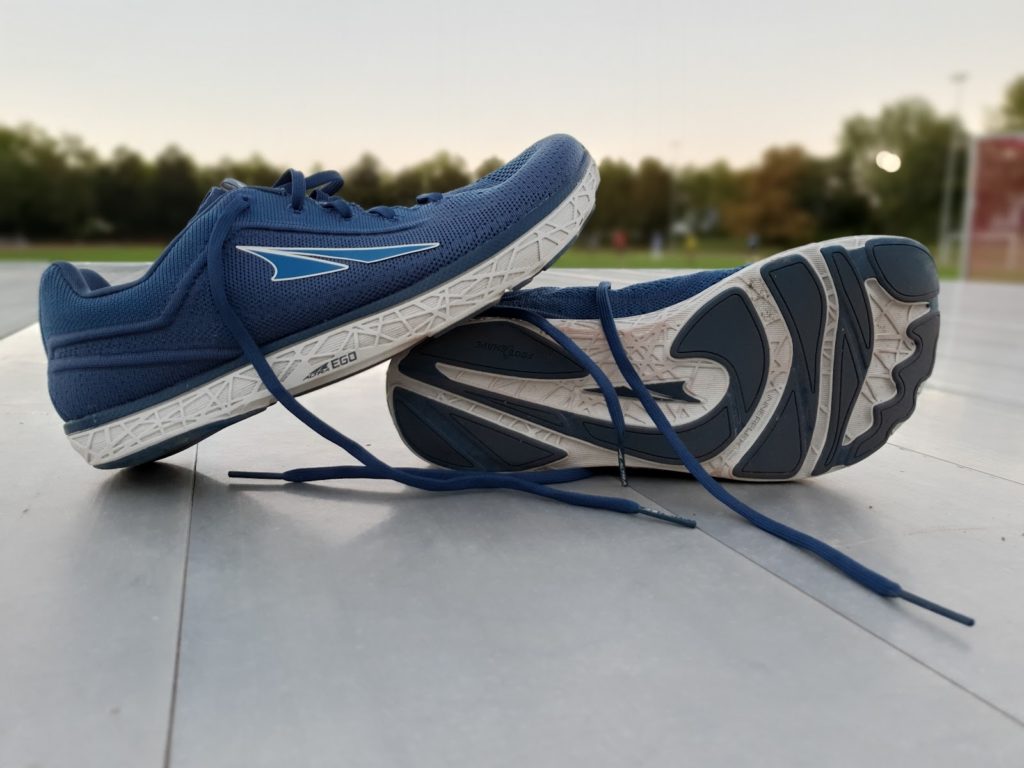
Altra’s wide toe box and zero drop: While Altra’s early shoes were pretty ugly, they identified two clear problems some runners had: crowded toe boxes and high heel:toe drops. While their wide toe boxes make it look like Altra runners have club feet, comfort is paramount and this easily distinguishable feature made it clear they had an answer.
Characteristics, not ingredients
To extend this point a bit, people can easily identify characteristics of shoes without knowing or caring about ingredient brands. Carbon plates are a good example of this right now. Carbon plates in race shoes are very popular. Can most runners name specific brands of carbon plates? No. But they certainly know which shoes have them, if only because they’re typically a lot more expensive and reinforced with marketing.
One newcomer brand worth pointing out here is Atreyu. They’re different than any of the other brands I came across in that they didn’t have any ingredient brands. They’re neutral ride and lightweight. Their race shoe has a carbon plate. But the only names are “Atreyu” and their shoes “The Base Model” and “The Race Model.” Simple. Let’s see if they keep it up after growing.
Zooming out on this messy landscape of ingredient brands, it’s fair to say the sheer volume and inconsistency of ingredient brands create a bunch of noise at best and take away from parent brand perception at worst. Sometimes the ingredients themselves are improvements, sometimes they aren’t. Really, it’s the brand’s running ethos and visually identifiable features that rule the day. Remember, just because you come up with something new, doesn’t mean you need to put a name on it and market it. Even if you do, chances are most people won’t remember. So keep it simple and stay focused—just like running.

